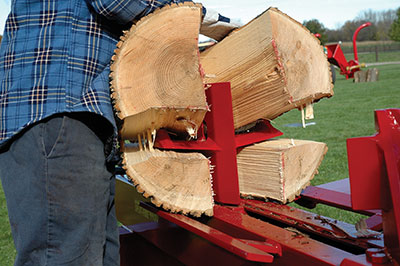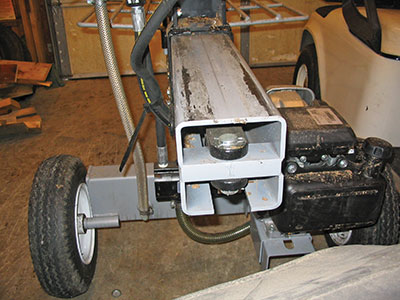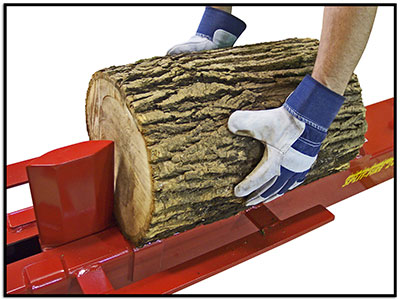
Getting a good split
By Chris Skalkos
Features Tech tipsIf your rental operation serves rural customers or cottagers, you are probably already renting wood splitters.
If your rental operation serves rural customers or cottagers, you are probably already renting wood splitters. With an average rental rate of $65 to 75 per day, wood splitters are hot rental items in both the spring and the fall with rental professionals recouping their cost for the machine within a two-year period, leaving plenty of life left in the splitter to continue generating more profits. But just like any other machine in your rental fleet, your return on investment will depend on the product’s safety record, performance and required maintenance.
 |
|
| Some wood splitters offer an optional 4-way wedge that provides the customer with the ability to quarter their wood in one stroke and can be sold as a productivity upgrade.
|
Just about every hydraulic self-contained wood splitter on the market does the same thing. They are simple machines designed to split wood into smaller pieces. Most end users renting splitters are not concerned about the brand, they just want a tool to get their wood piles split the easiest way possible. However, rental operators should look at several factors when choosing a supplier to make sure the quality is something they can stand behind.
If you have been dealing with wood splitters for any amount of time, you have probably discovered that not all wood splitters are made the same, nor do they perform equally. There are many companies manufacturing a variety of wood splitters, and knowing what to look for can make the difference when you are purchasing based on quality, efficiency and safety.
Safe splitting
First and foremost for any rental operation is safety. It is standard practice for rental professionals to educate customers about operating machinery safely. This ensures that the customer will be safe when using the machine and that your machine will be used with care on the jobsite. Knowing that the wood splitters you are renting have been designed for operational safety helps manage this risk. Wood splitters are inherently dangerous if used improperly, but that is no different than renting out a chainsaw or a mini-excavator. Every wood splitter will have a pinch-point in the splitting zone where fingers can get crushed. This is where the knife or wedge meets the log stop, which is usually a flat plate of steel. The greater the surface area of the flat plate log stop, or “push plate,” the more surface area is presented to the operator to have fingers pinched. Some manufacturers have designed log stops with smaller profiles which present less surface area for potential pinch-points when the operator is handling the wood during splitting.
Another contributing safety factor is “fly-outs,” where wood pieces or whole logs fly off the splitter, potentially striking the operator. This happens when the log is not pinched properly and the build-up of pressure causes the log to catapult off the splitter bed or causes split pieces of wood to fly outwards. This is something that can occur even when the splitter is being used correctly, especially if the logs being split have been cut on an angle. Rental operators can completely remove this liability from their splitters by choosing one that has a log stop design that will hold the log firmly in place even if it has been cut on an angle. This prevents wood from flying off unexpectedly, making the machine much safer to operate.
The added benefit of a low profile log stop design will also allow pressure to be relieved around the sides so the wood can move laterally instead of building up uneven pressure and forcing the log to pop out. The narrow profile of the front of the log stop contacts the wood in the centre of the frame. This keeps the pressure in the centre of the splitter instead of trying to push the blade or log stop over to one side or the other.
In addition to limiting the buildup of pressure, there are also dangers of hot hydraulic oil being sprayed over the operator in the event of a hydraulic hose failure. A quality-built wood splitter will use steel high-pressure hydraulic tubes which keep the oil relatively cool and will leak before they burst, greatly reducing this risk. In places where rubber hose is required, long, weak rubber hose should be replaced by one short, high-pressure hose designed for four times the nominal pressure used in the machine.
Design quality
Comparing apples to oranges among wood splitters is a matter of recognizing when good engineering and design principles have been incorporated into the machine. Tonnage ratings are one of the more obvious differences between wood splitters. Many of the models sold at discount supply stores have high tonnage ratings, but are still lower performing machines. This is due to the pressure ratings from the pump, which correlates to a certain amount of tonnage from the cylinder. Typically, these machines overstate their psi ratings, making it near-impossible to reach the stated performance levels. This is why a quality 20-ton splitter will outperform a low-quality 32-ton splitter in real world application.
 |
|
| An offshore low-quality wood splitter less than a year old showing stress fractures in the frame underneath the paint. The binding friction from the steel-on-steel slide assembly will impede the power of the ram and wear down the bearing area.
|
The frame type and the quality of steel used also plays an important role. Most splitters are built on an I-beam and use a wedge plate assembly sliding along it. The quality of the steel components and how they are mounted is important. Consideration should be given to the floating gib plate and adjustable shims and how easily they can be replaced. For greater quality, look for wood splitters manufactured with a square steel tube, which is much less susceptible to bowing or twisting than an I-beam.
The slide system on a splitter can also make a difference. A steel-on-steel or a brass-on-steel slide system may cause binding friction over time, which can impede the performance of the splitter. Quality wood splitters use a frictionless slide system to completely avoid the steel friction problem. Some have incorporated composite material wear pads built into the wedge. Others go to a greater degree by using low-friction slider pads made from ultra-high-molecular-weight polyethylene, which is self-lubricating and is highly resistant to abrasion. In some forms, UHMW polyethylene is 20 times more resistant to abrasion than carbon steel!
The slide guides on quality wood splitters are 30 inches long, which makes them last longer compared to other makes that have less than 10 inches. A low-quality splitter has very little bearing area, which is often steel or brass-on-steel. This will make edges sharp and dangerous, causing friction and lost power. The replaceable plastic slides, one square foot per side, on square-tube frame wood splitters provides a large bearing area enabling the machine to last much longer.
To hold up to the demands of the rental industry, wood splitters must be well-designed and built with quality materials and components. Rental operators need to understand the overall design and crucial slide assembly so they can purchase and serve customers with a top-notch, highly productive machine that will get the job done safely.
Options for upselling
Manufacturers offer several options for wood splitters that help increase the customer’s productivity and provide an upsell opportunity for the rental company. Added features such as a hydraulic lifter to hoist heavy logs can add another $25 – 30 dollars to the rental. It is an easy upsell once customers realize the add-on will do all the heavy lifting for them. Options such as a four-way wedge provide customers with the ability to quarter wood in one stroke and can be sold as a productivity upgrade. Bi-directional wood splitters that split logs in both directions provide an easily recognizable selling feature. The knife is splitting on the return stroke, doubling the productivity for customers since they don’t have to wait for the knife to retract before placing another log on the bed. Bi-directional wood splitters also solve a very common and frustrating problem with single-stroke machines: often a block of wood gets stuck on the knife and may need to be banged off with a sledge hammer, potentially causing damage to the splitting head. On a two-way splitter the operator only needs to place a block of wood on the other side of the knife and continue the opposite cycle to dislodge the stuck piece.
Customers feeding outdoor wood-burning furnaces or boilers may appreciate an extended stroke length, giving them up to 48 inches of travel. If your shop is in an area where customers will be towing the splitter into the bush on rough roads, you should ask about an upgraded suspension and axel. Conversely, urban renters might appreciate the highway towability option you can get on some models. An extended nose hitch will help customers who want to tow the splitter behind an ATV or lawn tractor.
These are only a few factors to consider when choosing a wood splitter for your rental operation. Having the ability to identify a quality machine and convey its features and benefits to customers can help you profit from wood splitter rentals in your market.
Hands on the bark!

|
|
When using wood splitters rental operators can prevent customers from being injured, not only by educating them on the proper operation of the machine but also on proper splitting techniques. Even when the machine is turned off, holding blocks by the butt end can cause hands and fingers to be pinched if bumped between the push plate, a log-stop or the splitting head and the block. Accidents can be avoided by never handling the blocks or logs by the sawn ends. Always grab logs on the bark side. For handling oversized logs, it is easier to grab them by the sawn ends only to place them on the shelf edge of the wood splitter, and then move the hands on the bark side to roll them into place for splitting. Understandably, it does feel awkward to grab the logs by the round instead of at the sawn ends, but emphasizing this practice to customers will keep their hands and fingers away from pinch points at all times.
Chris Skalkos is the marketing director for Split-Fire Sales Inc, in Norwich, Ont. Split-fire is a family owned business specialized in manufacturing high quality hydraulic wood splitters and chippers for more than 29 years. All Split-Fire wood splitters and chippers are custom designed & manufactured by the company in Canada and sold worldwide.
Print this page
Leave a Reply